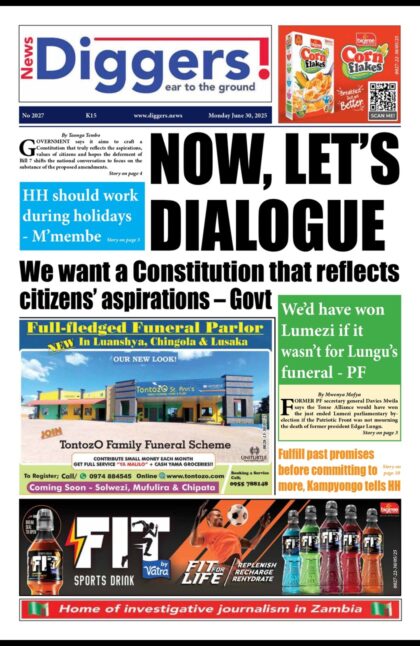Zambia’s external debt has leaped to over US$10 billion for the first time in the country’s history, as debt servicing commitments equally increased to unprecedented levels of nearly US$760 million last year.
And government missed its 2018 fiscal deficit target threshold of not exceeding more than 6.4 per cent relative to Gross Domestic Product (GDP) last year by recording 7.6 per cent.
In a budget and Treasury brief released by the Ministry of Finance, Monday, Zambia’s external debt has increased to an unprecedented US $10.05 billion as at December 31, 2018, compared to US $8.74 billion by the end of 2017.
Data also reveals that the country’s domestic debt also climbed to over K58 billion by the end of last year, up from K48.4 billion in 2017.
“As at end December, 2018, external debt was US $10.05 billion compared to US $8.74 billion at the end of 2017. The rise is attributed to INCREASED DISBURSEMENTS ON PREVIOUSLY CONTRACTED LOANS for on-going economic infrastructure programmes aimed at supporting economic diversification and structural transformation,” the statement read.
“Domestic debt stood at K58.3 billion at the end of 2018 compared to K48.4 billion in 2017. The increase was partly due to the government’s effort to realign the composition of Zambia’s public debt in line with the Medium-Term-Debt-Strategy. Domestic debt service in 2018 was K8.20 billion compared to K5.5 billion in 2017.”
Data showed that government’s external debt interest payments continued rising last year to hit nearly US $760 million.
“External debt service during the period was US $759.9 million and government guaranteed debt stood at US $1.3 billion. Interest payment on total debt was K13.6 billion of which K6.2 billion was on external debt. The high interest payment on external debt is partly explained by the depreciation of the kwacha against the United States dollar. This notwithstanding, other expenditure lines were constrained in line with government’s objective to minimise expenditure on minimal priority programmes and projects,” it stated.
Government’s domestic arrears owed to contractors and suppliers also continued rising to unprecedented levels of K15.1 billion by the end of last year, up from K14.7 billion by the end of the third quarter of 2018.
“At the close of 2018, total domestic arrears stood at K15.1 billion. In an effort to dismantle the arrears, a total of K4.5 billion was paid out in 2018 against the budget target of K1.3 billion budget,” it read.
And government missed its 2018 fiscal deficit target threshold of not exceeding more than 6.1 per cent relative to Gross Domestic Product (GDP) last year by recording 7.6 per cent.
In one of the PF government’s macroeconomic objectives, the Ministry of Finance projected to limit the overall fiscal deficit to 6.1 per cent of GDP on a cash basis.
“The fiscal balance [deficit] for the year remained elevated at 7.6 per cent. This is slightly lower than the 2017 deficit of 7.9 per cent,” read the statement.
Government’s spending on serving external debt has drastically leaped to nearly K15 billion in this year’s budget, more than double the amount of K7.26 billion allocated in the 2018 budget.
Zambia’s cost of external debt servicing has drastically risen since 2013.
According to World Bank data, Zambia’s external debt servicing in 2013 was around US $63 million, but has since jumped to hit US$759.9 million last year, up from around US $706 million in 2017.
In January alone, government splashed K2.5 billion in debt servicing repayments out of a total of K5.7 billion that was released by the Ministry of Finance to fund various government operations, representing nearly 50 per cent of the total budgetary allocation.
Stakeholders have broadly criticized the PF’s fiscal consolidation agenda in this year’s budget as an illusion as government is expected to borrow even more and increase taxes to service the mounting public debt.



















